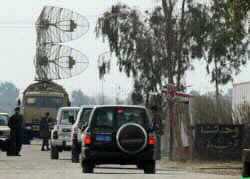U.N. Inspectors Visit Iraq Missile Plant
11/02/2003| IslamWeb
 U.N. inspectors paid a surprise visit to a Baghdad missile plant Tuesday as international experts met behind closed doors in New York to assess whether Iraq's short-range missiles can fly farther than permitted under U.N. edicts. In their daily rounds of inspections, conducted despite a Muslim holiday in Iraq, a U.N. team went to the 17th of Nissan factory, which makes molds and casts, including components for Iraq's al-Samoud ballistic missiles, the Information Ministry reported.
U.N. inspectors paid a surprise visit to a Baghdad missile plant Tuesday as international experts met behind closed doors in New York to assess whether Iraq's short-range missiles can fly farther than permitted under U.N. edicts. In their daily rounds of inspections, conducted despite a Muslim holiday in Iraq, a U.N. team went to the 17th of Nissan factory, which makes molds and casts, including components for Iraq's al-Samoud ballistic missiles, the Information Ministry reported.
Chief weapons inspector Hans Blix reported to the Security Council on Jan. 27 that Iraq's liquid-fueled al-Samoud 2 missile reached a maximum of 113 miles in test flights, passing the limit of 94 miles set under U.N. resolutions imposing controls on Iraqi arms since the 1991 Gulf War .
The Iraqis say that, when operational, the missile's range will fall below 94 miles.
The findings of the two-day experts meeting that ends Tuesday at U.N. headquarters in New York may be incorporated in an update report Blix must file with the Security Council of Friday. If the missile is found in violation, Blix's U.N. inspection agency is expected to demand modifications and to plan continued monitoring of the Samoud 2 arsenal.
The reports Friday by Blix and chief nuclear inspector Mohamed ElBaradei are expected to help decide the next steps to be taken by the Security Council in the long-running Iraq crisis.
The council majority, led by France, Germany and Russia, want to continue the inspections and oppose U.S. plans for early military action against Iraq, if in the U.S. view it has not disarmed adequately.
Iraq took steps Monday to try to win a chief inspectors' report on Friday that is more positive than their mixed assessment of Iraqi cooperation Jan. 27.
In one move, after weeks of resistance to U-2 reconnaissance overflights, Baghdad agreed to allow the American-piloted planes to conduct surveillance on behalf of U.N. inspections. The Iraqi government also told the chief inspectors it would enact legislation banning weapons of mass destruction in Iraq, as demanded by the United Nations .
After two days of talks in Baghdad last weekend, Blix said he had detected an improved "positive attitude" on the Iraqis' part. In Washington, however, President Bush dismissed the Iraqi concession on the U-2, saying it came from "a man who is trying to stall for time" - a reference to Iraqi President Saddam Hussein .
The Bush administration suffered another setback Monday when Germany, France and Belgium blocked a U.S. move to initiate NATO alliance preparations for war with Iraq.
The Baghdad newspaper Babil editorialized Tuesday that this represented a historically important "slap" at Washington. It said the United States views an increasingly independent Europe as a "competitor" that would "put an end to U.S. hegemony that has led to a growing number of wars and conflicts that the United States is behind."
In another development, a special envoy from Pope John Paul II, Cardinal Roger Etchegaray, was en route to Baghdad with a message for Saddam that the pontiff hoped may help ease the crisis. "This threat which is looming here in this region is very dangerous," the cardinal said on a stopover in Amman, Jordan.
On the first day of the four-day Eid al-Adha holiday, U.N. teams also visited Iraq's main nuclear complex at Tuwaitha, a site south of Baghdad inspected many times, and conducted a mobile survey for radiation - clues to possible nuclear weapons work - in the Baghdad district of al-Bu'aeitha.
Security Council resolutions adopted since Iraq's defeat in the Gulf War have prohibited chemical, biological and nuclear weapons programs in Iraq, and limit its missiles to the 94-mile range.
Inspectors in the 1990s oversaw destruction of the bulk of chemical and biological weapons, and dismantled Iraq's program to try to build nuclear weapons. The inspections resumed last November, after a four-year gap, to search for any remaining weapons or revived programs.
The Iraqi government has filed detailed reports to the United Nations on missile development and testing. In addition to the al-Samoud 2, Iraq's al-Fatah solid propellant missile surpassed the U.N. range limit eight times during 33 tests, Blix has told the Security Council, according to diplomats.
After the weekend talks here, Blix told a news conference the Iraqis turned over papers relating to the two missile types, but he gave no details.
He has said the Iraqis suggested previously that when they fitted guidance and control systems and other devices to the missiles, they would be weighed down and fly less than the allowed distance.
In his January report, Blix also noted that the diameter of the al-Samoud 2 was increased to 30 inches, despite a U.N. directive limiting the diameter to less than 23 inches.
PHOTO CAPTION
A United Nations weapons inspection team reaches an Iraqi military facility in Arabejbour, 40 kms (25 miles) southwest of Baghdad Tuesday, Feb. 11, 2003. (AP Photo/Jassim Mohamme
www.islamweb.net
